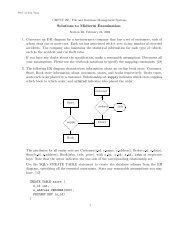CMPUT 340—Introduction to Numerical Methods - Department of ...
CMPUT 340—Introduction to Numerical Methods - Department of ...
CMPUT 340—Introduction to Numerical Methods - Department of ...
Create successful ePaper yourself
Turn your PDF publications into a flip-book with our unique Google optimized e-Paper software.
<strong>CMPUT</strong> <strong>340—Introduction</strong> <strong>to</strong> <strong>Numerical</strong> <strong>Methods</strong><br />
Assignment 3<br />
Winter 2007<br />
<strong>Department</strong> <strong>of</strong> Computing Science<br />
University <strong>of</strong> Alberta<br />
Due: Wednesday, March 28 at 23:59:59 local time<br />
Worth: 15% <strong>of</strong> final grade<br />
Instruc<strong>to</strong>r: Dale Schuurmans, Ath409, x2-4806, dale@cs.ualberta.ca<br />
Note: For this assignment you will need <strong>to</strong> go <strong>to</strong> the course webpage and download the file<br />
a3files.zip. Unzipping this file will create 4 files, data1.mat, quadfeatures.m, quadkernel.m,<br />
and gausskernel.m, which will be needed. You need <strong>to</strong> submit the answers <strong>to</strong> all written<br />
questions in hard copy <strong>to</strong> the course drop box. Matlab functions need <strong>to</strong> be submitted in<br />
.m files. You can submit your files by typing “astep -c c340 -p a3 file1 file2 ...”. See<br />
http://ugweb.cs.ualberta.ca/∼astep<br />
Note: For this assignment you are allowed <strong>to</strong> use the functions in help matfun, but not<br />
those in help stats.<br />
Part 1 (Linear least squares—2%)<br />
(a) (1%) Write a Matlab function [w1] = fitlin(X,y) which returns a vec<strong>to</strong>r <strong>of</strong> weights<br />
w1 corresponding <strong>to</strong> the minimum sum <strong>of</strong> squared errors linear function for predicting<br />
y given X.<br />
(b) (1%) Write a Matlab function [w2] = fitlinreg(X,y,lambda) which returns a vec<strong>to</strong>r<br />
<strong>of</strong> weights w2 corresponding <strong>to</strong> the minimum regularized sum <strong>of</strong> squared errors linear<br />
function. That is, return the weight vec<strong>to</strong>r w2 that minimizes<br />
t∑<br />
n∑<br />
(w · x i − y i ) 2 + λ wj<br />
2<br />
i=1<br />
j=1<br />
Part 2 (Generalized linear least squares—3%)<br />
(a) (2%) Write a Matlab function [w3] = fitgenlinreg(X,y,lambda,featurefun) which<br />
returns a vec<strong>to</strong>r <strong>of</strong> weights w3 corresponding <strong>to</strong> coefficients for the features determined<br />
in featurefun that minimizes the regularized sum <strong>of</strong> squared errors <strong>of</strong> predicting y<br />
given X.<br />
1
Note that your routine should take the name <strong>of</strong> a function featurefun as the last<br />
argument, and call this function using feval on the row vec<strong>to</strong>rs in X. A suitable feature<br />
function you can use, ’quadfeatures’, is provided in a3files.zip.<br />
(b) (1%) Write a Matlab function [yhat] = predictgenlin(Xtest,featurefun,w3) which<br />
returns a vec<strong>to</strong>r <strong>of</strong> predictions yhat for the row vec<strong>to</strong>rs in Xtest determined by the<br />
features in featurefun combined with weights w3.<br />
Part 3 (Comparison—2%)<br />
In this question you will compare the three different function estimation algorithms implemented<br />
above. They will be compared on synthetic data that has the form<br />
⎡<br />
⎤ ⎡ ⎤<br />
1 x 1,1 · · · x 1,n−1 y 1<br />
X = ⎢<br />
⎥<br />
⎣ .<br />
. ⎦ y = ⎢ ⎥<br />
⎣ . ⎦<br />
1 x t,1 · · · x t,n−1 y t<br />
The data will be generated as follows<br />
n = 2<br />
% dimension<br />
t = 10<br />
% training size<br />
u = [0; ones(n-1,1)]<br />
% target weights<br />
sigma = 0.1<br />
% noise level<br />
X = [ones(t,1) rand(t, n-1)] % training patterns<br />
y = (X*u).^2 + randn(t,1)*sigma % target values<br />
lambda = 0.005<br />
% regularization parameter<br />
Repeat the following steps 100 times and accumulate the sum <strong>of</strong> squared error for each kind<br />
<strong>of</strong> function in two tables: one for the training errors and one for the testing errors. Report<br />
the averages and the variances for the squared error <strong>of</strong> each kind <strong>of</strong> function in two tables<br />
(one training error and the other testing error).<br />
A: Generate a random training set X, y using the model, and solve for each kind <strong>of</strong> function:<br />
w1 = fitlin(X,y), w2 = fitlinreg(X,y,lambda), and w3 = fitgenlinreg(X,y,<br />
lambda,’quadfeatures’). The feature function ’quadfeatures’ is in a3files.zip obtained<br />
from the course webpage.<br />
B: Record the squared error that each <strong>of</strong> the three hypotheses obtained on the training<br />
data. To do this for each <strong>of</strong> the functions, you need <strong>to</strong> calculate the predictions yhat<br />
on the training data. For the first two functions, this can be easily done by calculating<br />
yhat1 = X*w1 and yhat2 = X*w2 respectively. For the third function, you need <strong>to</strong> use<br />
yhat3 = predictgenlin(X,’quadfeatures’,w3).<br />
C: Generate te = 1000 test examples using the same data generation process as above.<br />
Record the squared error that each <strong>of</strong> the three hypotheses generated in Step A obtained<br />
on the test data. This will require you <strong>to</strong> compute the yhat predictions on the<br />
test data, which can be done the same way as in Step B.<br />
Remember <strong>to</strong> submit all written answers in the course drop box.<br />
2
Part 4 (Linear least squares: Dual form—3%)<br />
(a) (2%) Write a Matlab function [a1] = fitduallinreg(X,y,lambda) which returns a<br />
vec<strong>to</strong>r <strong>of</strong> training example weights a1 such that X ⊤ a 1 = w 2 . That is, a1 corresponds<br />
<strong>to</strong> the dual linear solution <strong>of</strong> w2 for minimizing the regularized sum <strong>of</strong> squared errors<br />
for predicting y given X.<br />
(b) (1%) Write a Matlab function [yhat] = predictduallin(Xtest,X,a1) which returns<br />
a vec<strong>to</strong>r <strong>of</strong> predictions yhat for the row vec<strong>to</strong>rs in Xtest determined by the dual weight<br />
vec<strong>to</strong>r a1 combined with training data X.<br />
Make sure <strong>to</strong> check that 4(a) combined with 4(b) yield the same final predictions as the<br />
weights w2 determined in 1(b).<br />
Part 5 (Kernel least squares—3%)<br />
(a) (2%) Write a Matlab function [a2] = fitdualgenlinreg(X,y,lambda,kernel,par)<br />
which returns a vec<strong>to</strong>r <strong>of</strong> training example weights a2 corresponding <strong>to</strong> the dual solution<br />
(for the feature representation implicit in the kernel function) that minimizes<br />
the regularized sum <strong>of</strong> squared errors <strong>of</strong> predicting y given X.<br />
Note that your routine should take the name <strong>of</strong> a function kernel as the second last<br />
argument. The last argument par serves as a parameter that is passed <strong>to</strong> the kernel.<br />
So in particular, the kernel function must be called using feval(kernel,X1,X2,par).<br />
A suitable kernel function you can use, ’quadkernel’, is provided in a3files.zip. (Note<br />
that ’quadkernel’ corresponds <strong>to</strong> the same feature representation as ’quadfeatures’<br />
above, but it does so in a much more efficient way.)<br />
(b) (1%) Write a Matlab function [yhat] = predictdualgenlin(Xtest,X,kernel,par,a2)<br />
which returns a vec<strong>to</strong>r <strong>of</strong> predictions yhat for the row vec<strong>to</strong>rs in Xtest determined<br />
by the dual weight vec<strong>to</strong>r a2 combined with the training data X using the features<br />
implicitly defined in the kernel with parameter par.<br />
Make sure <strong>to</strong> check that 5(a) combined with 5(b), using the kernel ’quadkernel’, yields the<br />
same final predictions as 2(a) combined with 2(b) using the feature function ’quadfeatures’.<br />
Note that ’quadkernel’ ignores the parameter par, but other kernels, such as ’gausskernel’,<br />
do not.<br />
3
Part 6 (Real data comparison—2%)<br />
In this exercise you will tackle a real world prediction problem. The problem is <strong>to</strong> estimate<br />
how <strong>to</strong> predict the log volume <strong>of</strong> a prostate cancer tumor (lcavol) from 7 clinical<br />
measurements: <strong>to</strong>tal log weight <strong>of</strong> the prostate (lweight), age <strong>of</strong> the patient (age), log <strong>of</strong><br />
benign prostatic hyperplasia amount (lbph), seminal vesicle invasion (svi), log <strong>of</strong> capsular<br />
penetration (lcp), Gleason score (gleason), percent Gleason scores 4 or 5 (pgg45 ).<br />
The datafile data1.mat is provided in a3files.zip. If you type “load data1.mat” in Matlab,<br />
you will load the training data in<strong>to</strong> a matrix X and a vec<strong>to</strong>r y and the test data in<strong>to</strong> a<br />
matrix Xtest and a vec<strong>to</strong>r ytest. Each row <strong>of</strong> the matrices corresponds <strong>to</strong> a 7 dimensional<br />
vec<strong>to</strong>r containing the clinical measurements for a patient, and the corresponding entry in the<br />
associated y-vec<strong>to</strong>r gives the discovered log volume <strong>of</strong> the patient’s prostate cancer tumor.<br />
The goal is <strong>to</strong> estimate a function that can predict the log volume <strong>of</strong> the prostate cancer<br />
tumor from the vec<strong>to</strong>r <strong>of</strong> 7 clinical measurements. Here, functions will be estimated on the<br />
training data and then tested on the separate test data.<br />
Use the following parameters <strong>to</strong> estimate different prediction functions:<br />
load data1.mat;<br />
ww1 = fitlin(X,y);<br />
ww2 = fitlinreg(X,y,25);<br />
ww3 = fitgenlinreg(X,y,1e5,’quadfeatures’);<br />
aa1 = fitdualgenlinreg(X,y,1e5,’quadkernel’,0);<br />
aa2 = fitdualgenlinreg(X,y,0.005,’gausskernel’,50);<br />
Report the mean sum <strong>of</strong> squares error that each <strong>of</strong> these four functions make on both the<br />
training and the test data. Which <strong>of</strong> these techniques do you think performs the best on<br />
this data? Why?<br />
Remember <strong>to</strong> submit all written answers in the course drop box.<br />
4




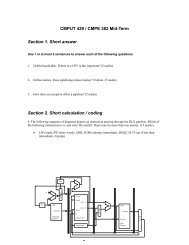

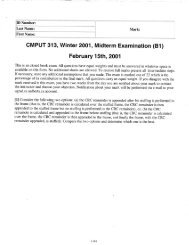
![CMPUT 313 Final Exam [Harms] April 26, 2000 g L (Ilosed Book](https://img.yumpu.com/45617471/1/190x245/cmput-313-final-exam-harms-april-26-2000-g-l-ilosed-book.jpg?quality=85)
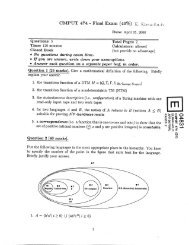
![CMPUT 379 Midterm Exam [Harms]](https://img.yumpu.com/44750568/1/190x245/cmput-379-midterm-exam-harms.jpg?quality=85)



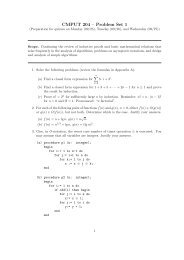

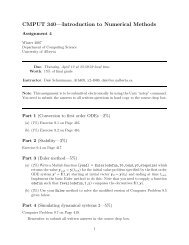
![CMPUT 272 Midterm [B2 -- Harms]](https://img.yumpu.com/36401258/1/190x245/cmput-272-midterm-b2-harms.jpg?quality=85)
